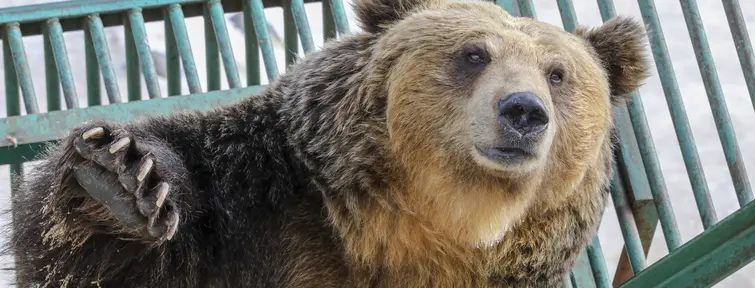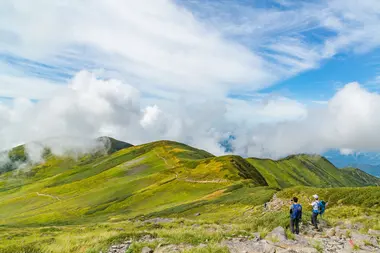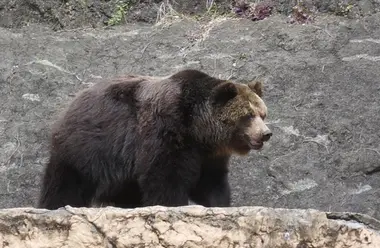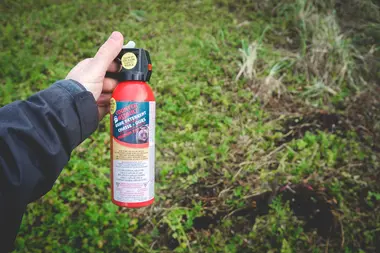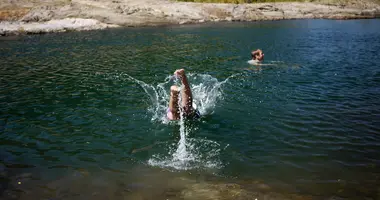Staying safe from bears when in Japan—tips and advice for hiking and camping!
- Published on : 20/11/2025
- by : Joshua
- Youtube
Japan is a great country for outdoor activities, but bears call nature home! Read on for more advice on staying safe in Japan and what to do when you encounter a bear!
Japan is a country with distinct geography. 70 to 75% of the archipelago is mountainous, defining landmarks of the island nation’s natural landscape.
Nature has played and continues to play an important role in Japanese everyday life, from history and culture to recreational activities. Indeed, hiking is a major hobby for many in Japan, a great opportunity to take in the gorgeous nature and the dynamic ecosystem it is host to. The beautiful scenery comes alive, home to animals like tanuki, deer, Japanese serows, and, of course, bears.
Yes, like in much of the world, bears claim the rolling mountains and dense forests as their home in Japan, and such is important to keep in mind if one is to go out and enjoy the wilderness!
In the fall of 2025, Japan has seen a large uptick in wild bear sightings, especially in the northern prefectures such as Akita and Hokkaido. This has caused some alarm for outdoor enthusiasts from both within Japan and abroad, but this doesn’t mean that the beautiful nature of the country should be fully avoided.
Just like in any other country with a bear population, adventurers trekking through the mountains and forests will have to practice and prepare the right precautions to both prevent bear encounters and be ready if such things occur!
Read on for more information in regard to hiking and bear encounters in Japan!
Bears in Japan
Japan is home to two different bear species:
Asiatic Black Bear
Distributed through the main island of Honshu and through the island of Shikoku, though in much smaller numbers. They are known for the distinct, moon crescent-shaped markings on their chest, causing them to also be known as “moon bears.”
Male black bears range from 60 to 120 kg (130-260 lbs) and females around 40-100 kg. Given their higher distribution through the archipelago, attacks from these bears are more frequent.
Ussuri Brown Bears
The same species (though a different subspecies) as the brown bears found in North America and in Japan are only found in Hokkaido. They are much larger than their black bear counterparts, oftentimes rivaling Kodiak brown bears in size. They are often seen anywhere from 200 kg (440 lbs) to 300 kg (660 lbs).
The bears of these species typically follow a more plant-based diet but are more aggressive than the black bears towards humans. Attacks from these bears are less frequent but typically more dangerous.
Bear behavior and habits in Japan
Typically, bears in Japan will run away and avoid humans when encountered, but aggression increases when cubs are present or when food is scarce.
Bears are most active at dusk and twilight hours. Additionally, bears will be more out and about during late fall, right before winter, as they prepare for torpor hibernation.
Winter hibernation for bears in Japan typically ranges from December to March or April of the following year. It’s important to note that not all bears in Japan will hibernate, as it has been observed that often times bears who have not eaten enough will continue to be active during the colder months.
Remember, if you ever see bear cubs, the mother is very likely to not be too far away. Never get in between a bear mother and her cubs.
Preparing for bear encounters in Japan
The best way to prepare for a bear encounter when traveling through the Japanese countryside is prevention. Though nature is often unpredictable, there are precautions to take to optimize both your enjoyment and safety!
1. Avoid bear encounters as much as possible
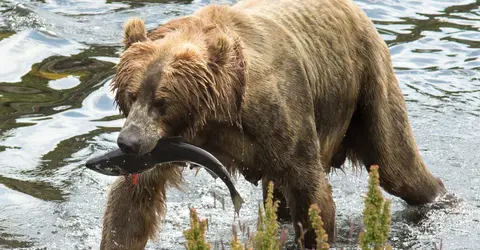
Brown bear eating a fish
Photo by Hupp Lisa USFWS on Pixnio
The mountains and nature are the bears’ domain and should be respected as such. Throughout different seasons, bears will have a generally more prominent presence as well as being more active in certain areas.
- Summer: Bears will often be found in higher elevation areas with grassy terrain, often foraging for food like berries, vegetation, and insects.
- Autumn: In late autumn, bears are more active, often in and around rivers eating fish to prepare for winter hibernation.
- Winter: While many bears are hibernating during this time, those that are still looking for food will still be wandering, and many may still wake up and be active on occasion, as they are entering torpor (slowed metabolism) rather than truly hibernating.
- Spring: Bears may be more active during this time as hibernation ends and they are looking for food after emerging. Late spring to early summer is mating season for bears in Japan, typically.
As previously mentioned, throughout the year, bears are generally more active between dusk and twilight, right before and a bit after the sun sets. Bears will most often be out and about in late autumn as they prepare for hibernation. Though the weather during this time is very mild and often nice for hiking, it may also be the time when a bear encounter is most likely to occur. Be sure to account for this when planning your outdoor activities!
Prominent sites for bears in Japan are often signified with signs, be it with a silhouette of the animal or with more creative or blatant warning signs depending on how prevalent they are in the area. Be sure to mind these warnings when deciding where and when to hike.
2. Make a lot of noise
Don’t be mistaken—bears in the wild are as scared, if not more scared, of humans than the other way around. A majority of bear encounters in Japan have the bears running away from the sight of humans, and in this vein, if a bear knows that a potential threat is in the area ahead of time, they will likely make their way to avoid them.
When hiking, not just in Japan, but anywhere where bears are prevalent, making consistent, notable noise while trekking along alerts other wildlife of your presence and to avoid such.
- Trail bear bells: Many trails in Japan will have larger bells posted along the way for hikers to ring and ward off bears. If you see them, be sure to ring them a few times to be safe.
- Personal bear bells: The effectiveness of personal bear bells is often up for debate, as, while they do consistently ring as you hike up, their sound may not be significant enough to properly ward off bears. While having one on your person isn’t advised against, it’s still best to take other precautions as well, such as using the aforementioned trail bear bells.
- Playing music: Having music playing without headphones is great for warding off unwanted encounters; it’s also a great means of entertainment. Given the right environment, feel free to sing along. Given that many hiking trails may be out deep in the wilderness, it’s best to download music on your devices for consistent access.
- Clapping and stomping: Making strong and powerful noises is important, especially around loud bodies of water where bears may be lingering around.
3. Hike in numbers if you can
With company comes support and also noise! The chit-chatter of fellow hikers plus the extra manpower will naturally deter wandering bears.
While hiking along, keep the conversation going and continue to make noise together as you go. Even just one additional person can make a big difference!
4. Carry bear spray
Bear spray operates much like things like pepper spray or mace, but it is formulated for bear encounters. Bear spray can be purchased on websites such as Amazon in Japan, as well as some specialty outdoor shops.
Be mindful of handling bear spray when not out in the wilderness, as having it out while in cities or more heavily populated areas is actually illegal. Save it for when you need it, but be sure to read the instructions properly so you know how to use it!
5. Don’t leave behind food or the scent of food
Bears want to avoid you if they can; however, they do want to find food. Be sure to bring all of your food and leftovers with you fully and to not leave a trail of food scent for bears to follow. If you will be camping and cooking, try to have your cooking set up a bit away from your sleeping area.
6. Check local regulations and advice
Depending on the situation during the season, local parks and government agencies will issue warnings about bear sightings and encounters. It’s important to heed these warnings that can range anywhere from “be careful” to “hiking in the area is prohibited at the moment.”
What to do if you encounter a bear in Japan
While it is always best to practice the above precautions to avoid potentially dangerous encounters with bears, the thing about nature is that it is very unpredictable. Just as it is important to know how to avoid bears, it is also important to know what to do if you encounter them!
- Stay calm and quiet: While making noise is important for avoiding bears, doing so when up front and personal with a bear may startle it and make it aggressive.
- Keep facing the bear: Your instincts may be to instantly turn around and run away, but this will just incite the chase response in a bear that is looking for prey. Trust us, they are much faster than you are. Remain calm and keep facing the bear.
- Make yourself appear larger: Raise your arms and, without making too much noise, make yourself appear to be bigger to deter the bear from approaching you.
- Slowly back away from the bear: While still facing the bear with arms up, slowly back away and increase the distance between you and the bear.
- In case of aggression, prepare your bear spray: If you notice increased aggression, prepare your bear spray by removing the safety clip.
- Ideally, you want to use the bear spray when a charging bear is around 9-18 meters (30-60 feet) away.
- Aim low and spray to make a cloud for the bear to run into.
- If the bear continues to charge, spray directly in its face.
- If a bear attacks, practice safety precautions: if worst comes to worst, protect yourself by curling into a ball with your back facing the bear, and be sure to cover your neck to protect it.
When hiking in Japan, a majority of people will likely not encounter a bear, and the chances of such are even smaller if they follow the proper precautions for avoiding them. Enjoying nature in Japan is something that ought to not be missed, and being prepared will help in making it be even more worthwhile!
Check out our outdoor activities in Japan!
Outdoor activities are a must for fully experiencing Japan! Check out our roster of nature-centric fun!
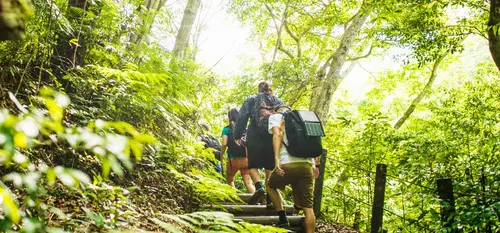
@canva
